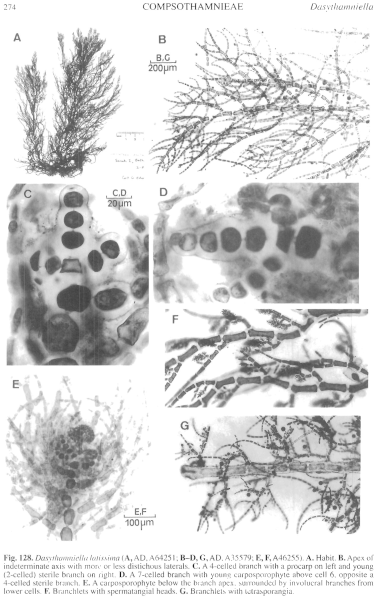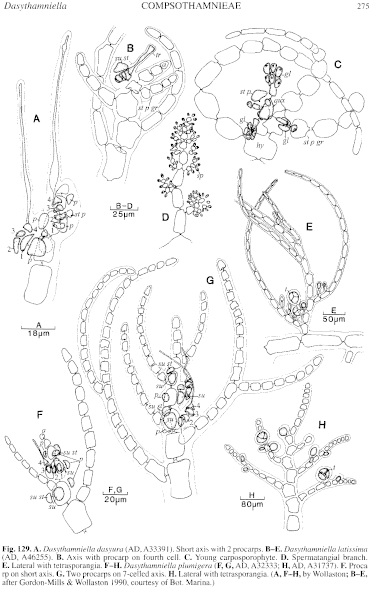|
|
|
|
|
|||||||||||
|
Electronic Flora of South Australia Species Fact Sheet
Phylum Rhodophyta – Order Ceramiales – Family Ceramiaceae – Tribe Compsothamnieae
Synonyms
Callithamnion latissimum Harvey 1844: 452; 1859b: 334. J. Agardh 1851: 50; 1876: 47. Sonder 1853: 674; 1881: 10.
Phlebothamnion latissimum (Harvey) Kützing 1849: 656; 1862: 3, pl. 8a, b.
Spongoclonium latissimum (Harvey) De Toni 1903: 1359. Lucas 1909: 49; 1927: 467, pl. 33; 1929a: 24.
Compsothamnionella huismanii Gordon-Mills & Wollaston 1990: 10, figs 1–15.
Thallus (Fig. 128A) erect and tufted, red-brown, 5–18 cm high, fastigiate with one to few axes and slender erect laterals. Branching regularly alternate and mostly distichous for 2–4 orders, corticated on lower axes. Holdfast 3–8 mm across, rhizoidal; epiphytic on Amphibolis or epilithic (often on shells). Structure. Apical cells dividing obliquely, increasing from 10–15 µm in diameter and L/D 1–2 to 500–600 µm in diameter and L/D (1.5–) 2–3 (–4) in the central part of the axes. Determinate branchlets 1–2 mm long, alternately distichous (Fig. 128B) but later becoming slightly spiral, not or slightly overlapping, with unbranched ends 200–600 µm and 8–17 cells long; cells in median parts (10–) 20–45 (–60) µm in diameter and L/D (2–) 3–4. The apical cell and ends of the axes are always emergent and never overtopped by lower laterals. Rhizoidal cortication is sparse above but denser and spongy below, the rhizoids entwined and connected by lateral pit-connections, increasing the axis diameter to 1–2 mm. Lateral indeterminate branches developing by continued growth of determinate laterals. Cells multinucleate; rhodoplasts discoid to elongate, ribbon like in larger cells.
Reproduction: Gametophytes dioecious. Procarps (Fig. 129B) borne on the third to fifth cell of short, 3–8-celled branches (Fig. 128C), with the fertile central cell bearing two periaxial cells, one (the supporting cell) cutting off a terminal sterile cell and a 4-celled, curved, carpogonial branch; the other periaxial cell forming a short sterile branchlet of 3–5 cells. An auxiliary cell is produced from the supporting cell and cuts off 2–4 successive gonimolobe initials (Fig. 129C) developing rounded groups of carposporangia (Fig. 128D, E) 180–350 µm across, each carposporangium angular and (15–) 20–25 µm across. The mature carposporophyte is surrounded by an involucre (Fig. 128E) of normal and additional curved lateral branchlets from the 2–3 axial cells just below the procarp; basal cells of the carposporophyte fuse somewhat but without forming a distinctive fusion cell. Spermatangial clusters (Fig. 128F, 129D) cylindrical, borne adaxially on the lower cells of branchlets, 25–45 µm in diameter and L/D 1.5–4, with 3–7 axial cells producing whorls of cells with ultimate spermatangia.
Tetrasporangia (Fig. 127G, 128E) are usually borne adaxially on lower cells of branchlets, pedicellate, 30–45 µm in diameter, tetrahedrally divided.
Type from Georgetown, Tas. (Gunn 1308); lectotype in BM.
Selected specimens: Muston, Kangaroo I., S. Aust., 2–3 m deep (Wollaston, 21.xi.1968; AD, A32978)? Crawfish Rock, Westernport Bay, Vic., 8 m deep (Watson, 17.xi.1974; AD, A46255 – type of C. huismanii). Georgetown, Tas. (Perrin, Jan. 1938; AD, A9012). Taroona, Tas., 3–6 m deep (Shepherd, 4.ii.1970; AD, A35170) and 0–10 m deep (Shepherd, 4.ii.1970; AD, A35579).
Distribution: Muston, Kangaroo I., S. Aust., Westernport Bay, Vic., and N and E Tasmania.
Taxonomic notes: Compsothamnionella huismanii Gordon-Mills & Wollaston is identical with the earlier described Callithamnion latissimum Harvey from Tasmania. The species occurs in relatively calm water habitats, whereas Dasythamniella wollastoniana is usually found on open coasts. Two collections listed by Gordon-Mills & Wollaston as C. huismanii (AD, A44558 and A28896) are now referred to D. wollastoniana; both are from open coasts, and one (AD, A55680 from Blanche Harbor, S.Aust., female only) differs from D. latissima in having 2 carpogonial branches per procarp, and the trichogynes with a prominent bulbous swelling. Determination of this taxon awaits further material. The Kangaroo I. specimen (AD, A32978) is tetrasporangial only.
References:
AGARDH, J.G. (1851). Species Genera et Ordines Algarum. Vol. 2, Part 1, I-XII, 1–336 + index. (Gleerup: Lund.)
AGARDH, J.G. (1876). Species Genera et Ordines Algarum. Vol. 3, Part 1- Epicrisis systematic Floridearum, pp. i-vii, 1–724. (Weigel: Leipzig.)
DE TONI, G.B. (1903). Sylloge Algarum omnium hucusque Cognitarum. Vol. 4. Florideae. Sect. 3, pp. 775–1521 + 1523–1525. (Padua.)
GORDON-MILLS, E. & WOLLASTON, E.M. (1990). Compsothamnionella huismanii sp. nov. (Ceramiales, Rhodophyta) from Southern Australia. Bot. Mar. 33, 9–17.
HARVEY, W.H. (1844). Algae of Tasmania. Lond. J. Bot. 3, 428–454.
HARVEY, W.H. (1859b). Algae. In Hooker, J.D., The Botany of the Antarctic Voyage. III. Flora Tasmaniae. Vol. II, pp. 282–343, Plates 185–196. (Reeve: London.)
KÜTZING, F.T. (1849). Species Algarum. (Leipzig.)
KÜTZING, F.T. (1862). Tabulae Phycologicae. Vol 12. (Nordhausen.)
LUCAS, A.H.S. (1909). Revised list of the Fucoideae and Florideae of Australia. Proc. Linn. Soc. N.S.W. 34, 9–60.
LUCAS, A.H.S. (1927). Notes on Australian marine algae. IV. The Australian species of the genus Spongoclonium. Proc. Linn. Soc. N.S.W. 52, 460–470, Plates 27–35.
LUCAS, A.H.S. (1929a). The marine algae of Tasmania. Pap. Proc. R. Soc. Tasm. 1928, 6–27.
SONDER, O.W. (1853). Plantae Muellerianae. Algae. Linnaea 25, 657–709.
SONDER, O.W. (1881). In Mueller, F., Fragmenta Phytographiae Australiae. Supplementum ad volumen undecinum: Algae Australianae hactenus cognitae, pp. 1–42, 105–107. (Melbourne.)
The Marine Benthic Flora of Southern Australia Part IIIC complete list of references.
Publication:
Womersley, H.B.S. (24 December, 1998)
The Marine Benthic Flora of Southern Australia
Rhodophyta. Part IIIC. Ceramiales – Ceramiaceae, Dasyaceae
©State Herbarium of South Australia, Government of South Australia
Illustrations in Womersley Part IIIA, 1998: FIGS 128, 129 B–E.

Figure 128 enlarge
Fig. 128. Dasythamniella latissima (A, AD, A64251; B–D,G, AD, A35579; E, F, A46255). A. Habit. B. Apex of indeterminate axis with more or less distichous laterals. C. A 4-celled branch with a procarp on left and young (2-celled) sterile branch on right. D. A 7-celled branch with young carposporophyte above cell 6, opposite a 4-celled sterile branch. E. A carposporophyte below the branch apex, surrounded by involucral branches from lower cells. F. Branchlets with spermatangial heads. G. Branchlets with tetrasporangia.

Figure 129 enlarge
Fig. 129. A. Dasythamniella dasyura (AD, A33391). Short axis with 2 procarps. B–E. Dasythamniella latissima (AD, A46255). B. Axis with procarp on fourth cell. C. Young carposporophyte. D. Spermatangial branch. E. Lateral with tetrasporangia. F–H. Dasythamniella plumigera (F, G, AD, A32333; H, AD, A31737). F. Procarp on short axis. G. Two procarps on 7-celled axis. H. Lateral with tetrasporangia. (A, F–H, by Wollaston; B–E, after Gordon-Mills & Wollaston 1990, courtesy of Bot. Marina.)

|
Email Contact: State Herbarium of South Australia |

|